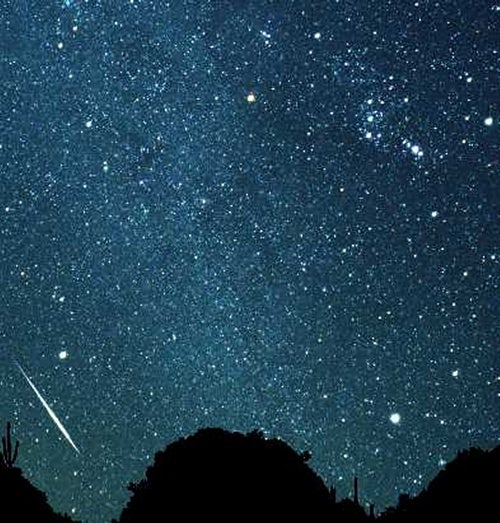
Those spending enough time under the night sky eventually will see a “shooting star,” a streak of light that flashes across the sky in less than a second. This is a meteor, a glowing trail caused by the incineration of a piece of celestial debris entering our atmosphere. Many meteors are quick flashes, but some last long enough for us to track their brief course across the sky. Now and then, a meteor truly will light up the night, blazing brighter than Venus — and although rarely, even brighter than the Moon — leaving in its wake a dimly glowing trail that may persist for minutes. Under a dark sky, any observer can expect to see between two and seven meteors each hour any night of the year. These are sporadic meteors; their source bodies — meteoroids — are part of the dusty background of the inner solar system.
Several times during the year, Earth encounters swarms of small particles that greatly enhance the number of meteors. The result is a meteor shower, during which observers may see dozens of meteors every hour. Concentrations of material within the swarms may produce better-than-average displays in some years, with rates of hundreds per hour. And every now and then, we’re treated to a truly spectacular display in which thousands of visible meteors can be seen for a brief period. These are referred to as meteor storms.
The meteors that appear during a meteor shower seem to radiate from one point in the sky. This illusion is an effect of perspective, just as a roadway seems to converge in the distance. Usually, meteor showers take the name of the constellation from which the meteors appear to radiate. For example, during the Perseid shower in August, meteors seem to streak from a point in the constellation Perseus. If a bright star happens to lie near the radiant, the shower may take the star’s name — for instance: the Eta (η) Aquarids.
What exactly are meteor showers and why are the best after midnight?
Most of the meteors seen during one of the annual showers arise from fluffy particles not much larger than sand grains. As a particle enters Earth’s atmosphere, it collides with gas atoms and molecules. The particle becomes wrapped in a glowing sheath of heated air and vaporized material boiled off its own surface. Meteors become visible at altitudes between 50 and 75 miles (80 and 120 kilometers), with faster particles typically shining at greater heights. Many of the faster, brighter meteors may leave behind a train — a dimly glowing trail that persists for many seconds or, more rarely, minutes. Larger debris may create a fireball — a spectacular meteor bright enough to outshine even Venus. Occasionally, a fireball will fragment; this event is accompanied by bright flares and even “sparks” thrown a short distance from the meteor’s main trail. Such a fireball is called a bolide.
The best way to enjoy a meteor shower is to dress warmly, set down a blanket or lawn chair at a dark site, get comfortable, and watch the stars. On any night of the year, meteors appear faster, brighter, and more numerous after midnight. That’s when your location has turned into Earth’s direction of motion around the Sun and plows into meteor particles nearly head-on, rather than having them catch up from behind. The peak activity of a meteor shower occurs in the hours when Earth passes closest to the orbit of the shower particles. The ideal circumstance for any observer is for the shower to peak at a time when its radiant is highest in the sky during the morning hours; most of the year’s best showers have the potential to meet these criteria.
A brief summary of the year’s best meteor showers follows.
Quadrantids
Generally visible between December 28 and January 6, the Quadrantids have a sharp activity peak around January 3. Typical rates vary between 40 and 100 per hour; about 5 percent leave trains. When the shower was first recognized as annual in 1839, the radiant occurred in a constellation no longer recognized — Quadrans Muralis (Wall Quadrant). It’s now divided between Hercules, Boötes, and Draco. The cold nights of northern winters and typically faint meteors keep this shower from being truly popular.
Until late 2003, this was the only major meteor shower whose parent body remained unknown. But that year astronomers found a near-Earth asteroid named 2003 EH1. When astronomers estimated the theoretical speed and radiant for a hypothetical meteor shower caused by particles from 2003 EH1, the results fell squarely in the middle of those measured for the Quadrantids by meteor observers. Astronomers suspect the object is a fragment from the breakup of a comet — and perhaps the event that gave birth to the Quadrantids.
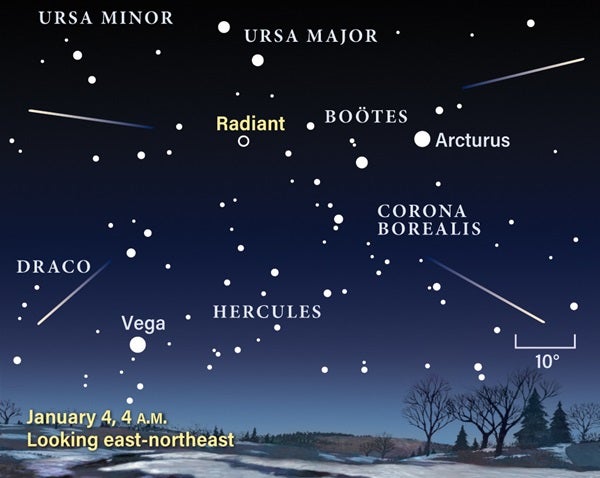
Lyrids
The Lyrids appear from April 16 to 25 and peak (at 10 to 15 per hour) around April 21; the radiant lies between Hercules and Lyra. Chinese observations of this display date back to 687 b.c., making the Lyrids the earliest recorded meteor shower. Astronomers recognized the Lyrids as an annual shower in 1839 and connected it it to its parent comet, C\1861 G1, in 1867. Lyrid meteors are bright and rather fast (30 miles [48 km] per second), and about 15 percent leave persistent trains.
Eta Aquariids
The first of the year’s two showers that derive from Halley’s Comet, the Eta Aquarids occur from April 19 to May 28, with a peak (10 to 20 per hour) around May 6. This shower is best for observers in the Southern Hemisphere, where the hourly rate climbs to about 50. The radiant is located near the Y-shaped asterism in Aquarius and named for one of those stars. The shower was discovered in 1870 and linked to Halley in 1876. The meteors are among the fastest (42 miles [67 km] per second) and are faint on average, but the brighter ones have a yellowish color; about 30 percent leave trains.
Southern Delta Aquariids
This is the most active of a diffuse group of streams and, as the name suggests, is best seen in the Southern Hemisphere. These meteors may be seen between July 12 and August 19 and peak (15 to 20 per hour) near July 28. The meteors are medium speed (27 miles [43 km] per second); they tend to be faint, and few leave trains.
Perseids
The best known of all meteor showers, the Perseids never fail to put on a good show and — thanks to the shower’s late-summer peak — are usually widely observed. The earliest record of this event comes from China in a.d. 36. Generally visible from July 17 to August 24, meteor speed (37 miles [60 km] per second), brightness, and a high proportion of trains (45 percent) distinguish the Perseids from other showers active at this time. It became the first meteor shower linked to a comet (109P/Swift-Tuttle) in 1865. Models of the Perseids predict a gradual decline in activity from a peak in 2004.
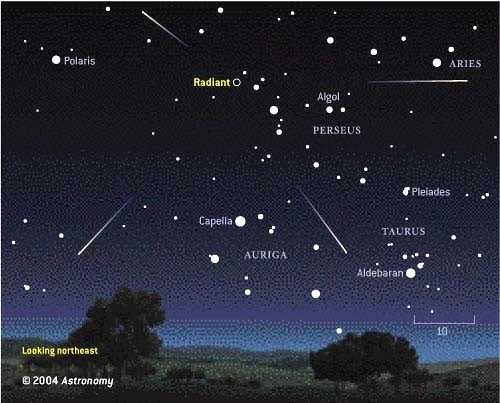
Astronomy’s travel partner, Eclipse Traveler, is offering a great adventure in Turkey to see the Perseids August 9-16, 2024. There is still time to register for the trip! A more detailed itinerary of the trip can be found on Eclipse Traveler’s website.
Draconids
The Draconids are sometimes called the Giacobinids; in a break with convention, this name honors the shower’s parent comet, 21P/Giacobini-Zinner. Draconid activity occurs between October 6 and 10, with a peak on October 8 (if it occurs at all). In 1933 and 1946, the shower produced brief but intense meteor storms (more than 5,000 per hour); in 1998, it reached a rate of about 500 meteors an hour over eastern Europe. The occurrence of the shower is intimately tied to the proximity of its parent comet. According to Donald Yeomans, a comet expert at the Jet Propulsion Laboratory in Pasadena, California, the most intense showers occur when Earth grazes the comet’s orbit within a few months of its passage. Most researchers agree that a full-fledged meteor storm — defined as 1,000 meteors an hour or more — will occur in 2018. Draconids are slow-moving meteors, encountering Earth at less than 12 miles (20 km) per second, and they typically are faint.
Orionids meteor showers
This is the sister stream of the Eta Aquariids, also arising from the debris of Halley’s Comet. Discovered in 1864, the Orionids were not linked to Halley until 1911. Orionid meteors can be found between October 2 and November 7, with a peak of about 25 per hour around October 21. Orionid meteors are among the fastest (42 miles [67 km] per second); they generally are faint, and about 20 percent leave trains that persist one or two seconds.
Southern Taurids
Visible between October 1 and November 25, this is the strongest of several streams originating from Comet Encke. A broad maximum occurs between November 3 and 5, but this shower usually brings an hourly rate of less than 15 meteors. The shower was first recognized in 1869 and was associated with Comet Encke in 1940. Its meteors generally are faint and quite slow (19 miles [30 km] a second) because they approach Earth from behind and must catch up.
Leonids
Leonid meteors generally arrive between November 14 and 21, with a peak hourly rate on November 17 of between 10 and 15 meteors per hour; about half of these meteors leave trains that can persist for several minutes. Because Earth runs into the orbiting particles almost directly head-on, Leonid meteors travel faster than those of any other shower — 45 miles (71 km) per second. The shower’s most notable feature is its habit of producing periodic, dramatic meteor storms as Earth intercepts streams of dense material ejected at previous returns of Comet Tempel-Tuttle. Our planet passed through such streams annually from 1998 to 2003. Computer models show that Jupiter’s tug on the dense Leonid streams causes them to miss Earth until at least 2098. Because the stream responsible for the predicted outbursts was ejected in 1933, only its smallest particles have been able to drift into a path that Earth will intersect. This means any outburst, if one occurs at all, will be rich in faint meteors.
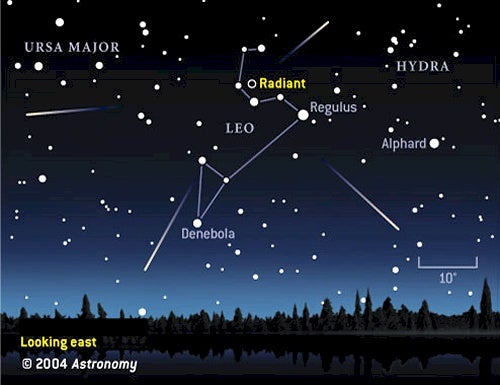
Geminids
The Geminids are active between December 7 and 17 and peak near December 13, with typical hourly meteor rates around 80 but occasionally more than 100. Because the Geminids intersect Earth’s orbit near the side directly opposite the Sun, this shower is one of the few that are good before midnight. The parent body of the Geminids is a curious object designated 3200 Phaethon. What makes Phaethon interesting is that it appears to be an asteroid instead of a comet. Planetary scientists suggest that many of the asteroids whose orbits cross Earth’s may be, in fact, worn-out comets.
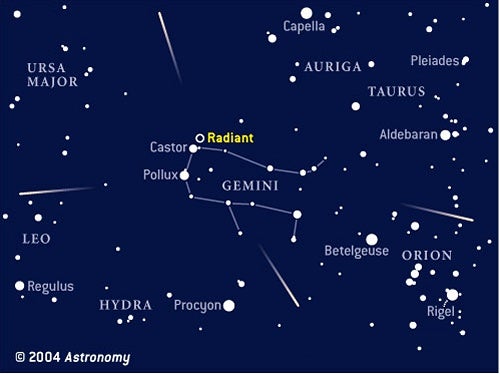
The science of meteor astronomy began in 1833, when a storm of 60,000 meteors an hour shocked the world. By the 1860s, it had become clear that many meteor showers were annual — including the normally placid Leonids, which produced the big storm — and that they were somehow related to comets. Astronomers now consider comets to be “dirty snowballs” consisting of a mixture of dust and frozen gases. A comet becomes visible only during its closest approach to the Sun, when areas on the comet’s icy surface become warm enough to evaporate. The resulting jets of evaporating gases carry with them any solid matter mixed with the original ice. At each pass near the Sun, the comet ejects a stream of material. The particles composing the stream orbit the Sun in slightly different paths than the source comet. Each particle receives small accelerations from forces other than gravity, and these orbits become increasingly modified over time. The ejected streams become more diffuse with age and lose their individual identities.
Concentrated initially near the comet, the debris diffuses along each stream’s orbit and eventually forms a thin band of material that Earth encounters every year. A meteor shower occurs on the date in the year when Earth passes nearest to the band of material associated with a comet’s orbit.
Editor’s note: This article was first published in 2010 and has been updated.









